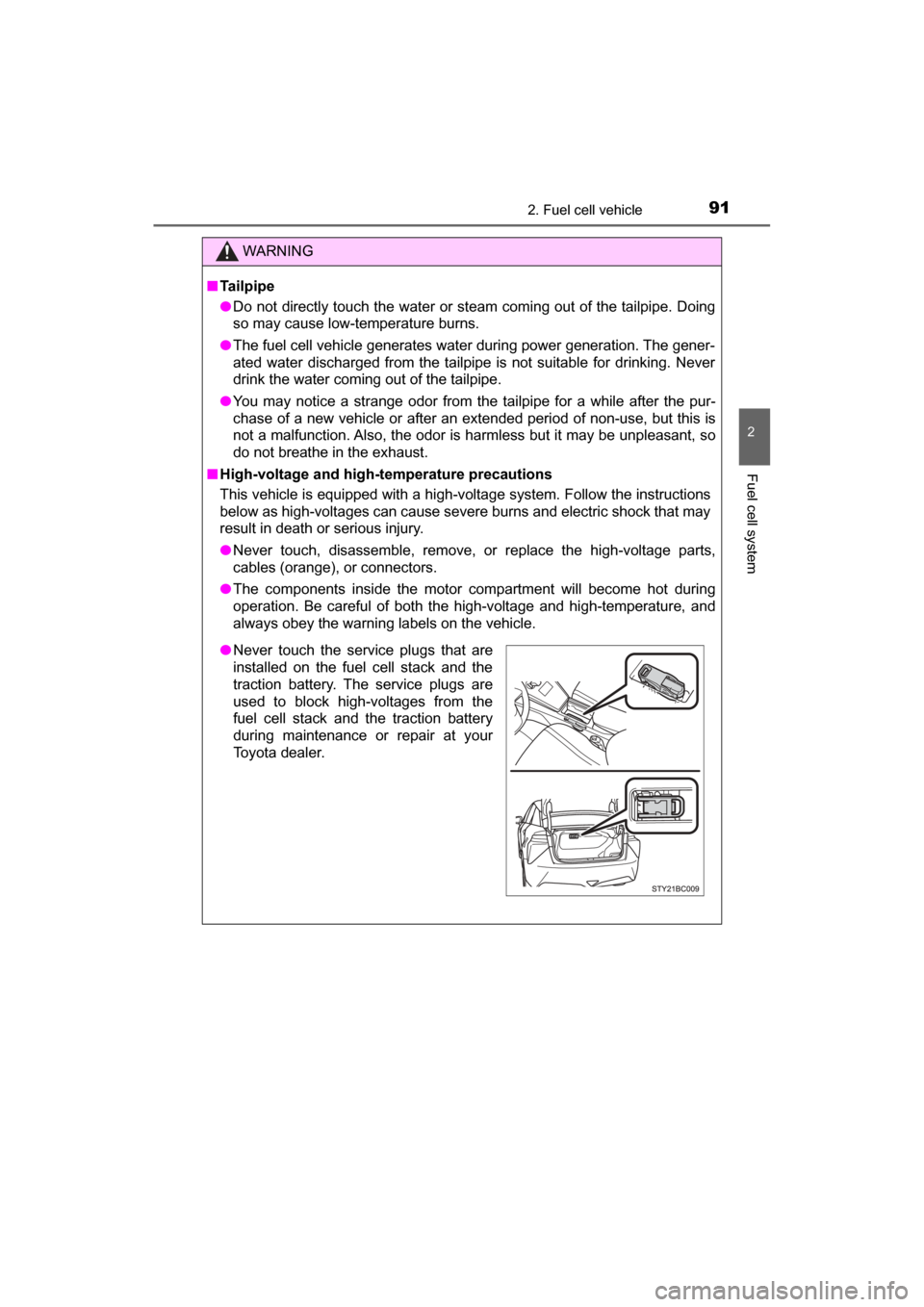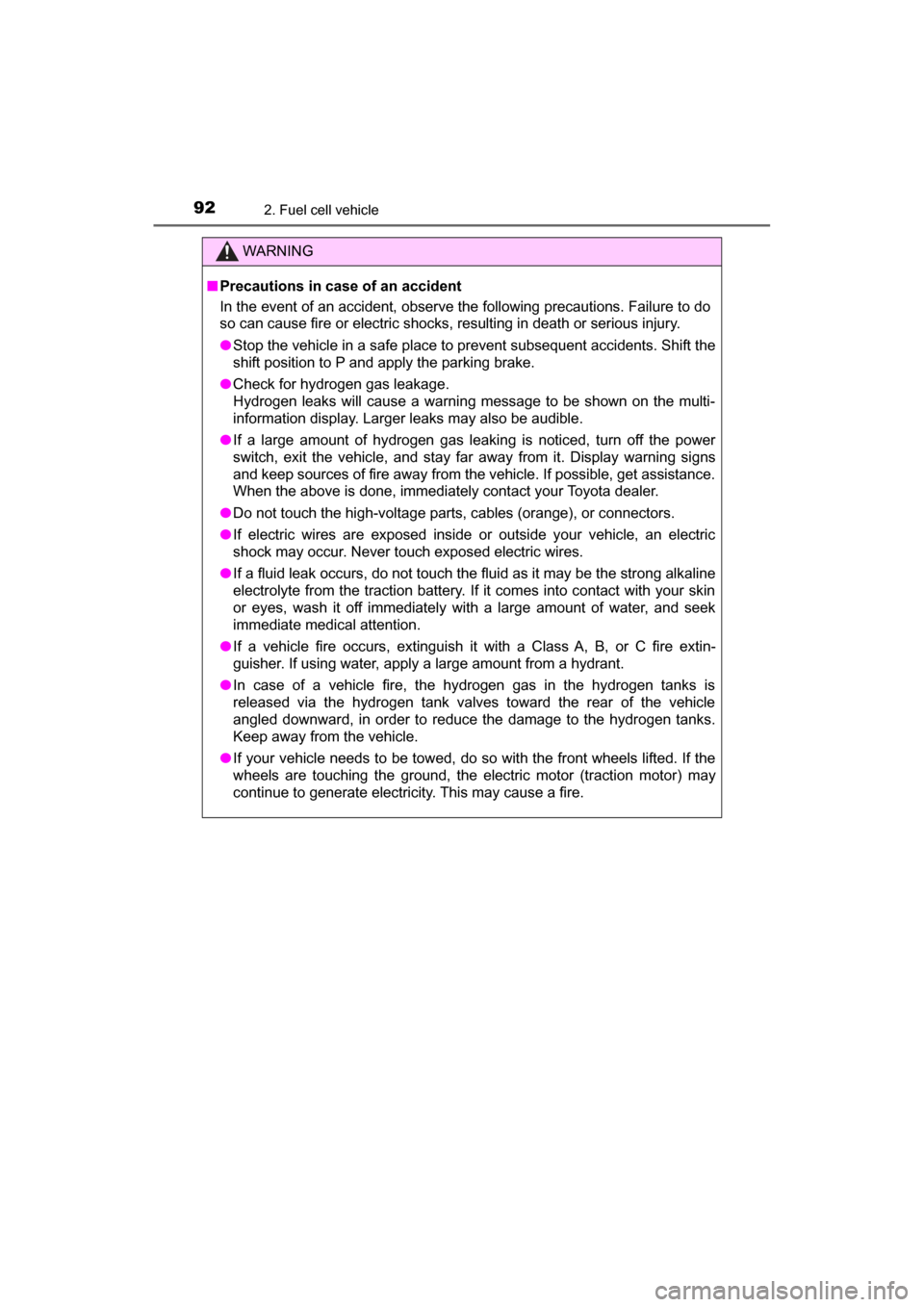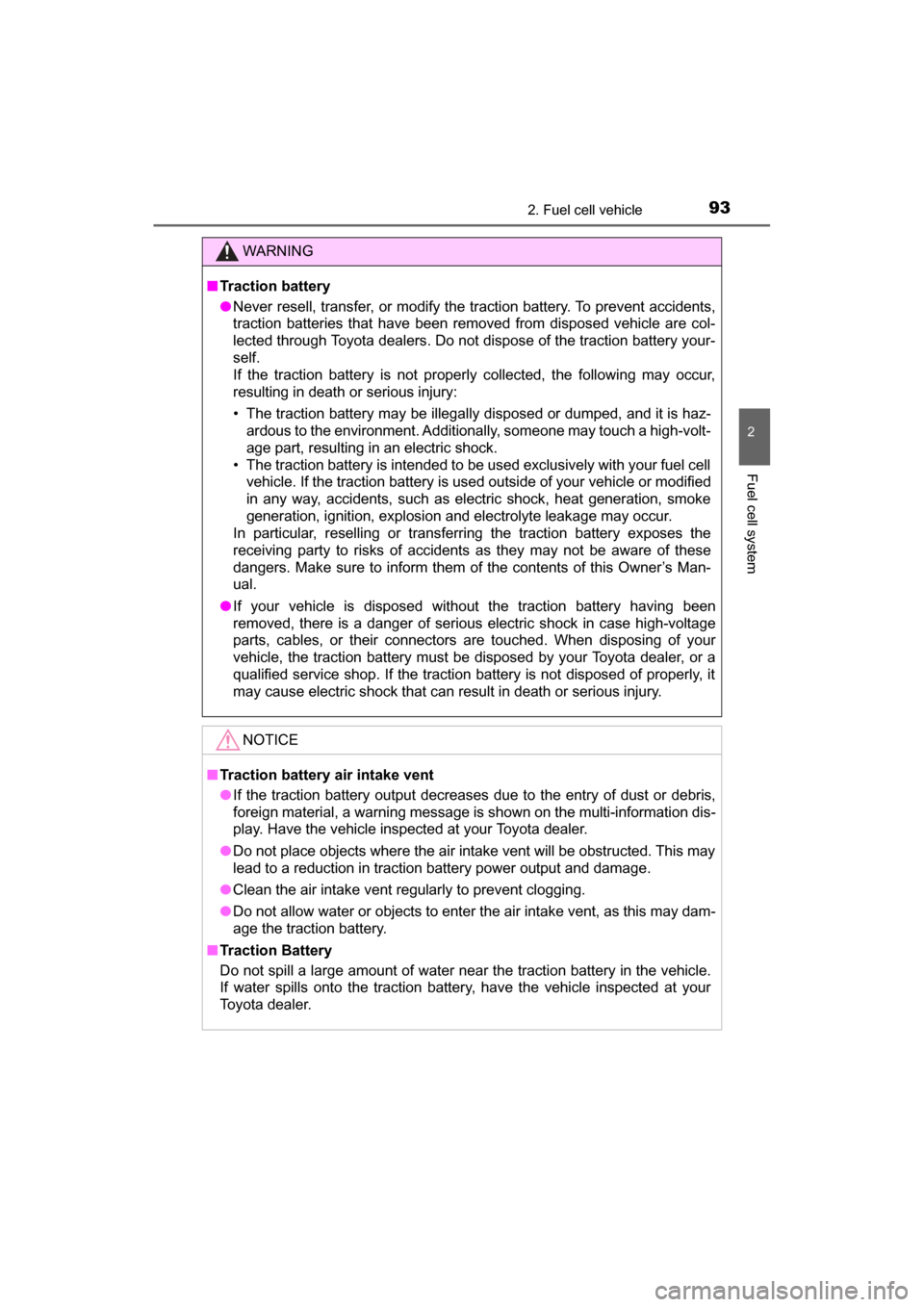Page 89 of 464

892. Fuel cell vehicle
2
Fuel cell system
MIRAI_OM_USA_OM62023U■
Hydrogen Gas Characteristics
●Hydrogen gas ignites more easily than gasoline. However, it is lighter than
air and disperses quickly. So even if hydrogen were to leak from the system,
it would quickly dilute until it is no longer flammable.
● As with gasoline and natural gas, hydrogen gas is not dangerous if it is han-
dled properly. Thoroughly read and understand the characteristics shown in
the table below.
Hydrogen gas
LPG
(Liquid Petroleum Gas)
Gasoline
Normal stateGaseous
(Lighter than air)Gaseous
(Heavier than air)
Volatile liquid
(evaporates
easily)
(Heavier than air)
Ease of
ignitionEasier than
gasolineAt the same level
as gasoline—
Ease of
accumulation
• Disperses
upward and is
diluted to safe
concentrations
in open air
• Does not adhere to
clothing
• Spreads on the
ground or floor
• Does not adhere to
clothing• Spreads on theground or floor
• Adheres to clothing
Detectability
•Due to itscolorless and
odorless state,
difficult to detect
by sight or smell
• Vehicle
hydrogen
detectors will
display a
warning on the
multi-
information
display
• Detectable by odor and gas
leaking noise• Detectable bycolor and odor
Page 90 of 464

902. Fuel cell vehicle
MIRAI_OM_USA_OM62023U■
Basic concepts of hydrogen safety
●Prevent leakage
The pipe joints of the hydrogen pipelines are designed to prevent leaks.
The joints are checked for gas leakage at every official vehicle inspection.
● Detect to stop leakage
• The vehicle is equipped with hydrogen detectors. If the hydrogen detec-
tors detect a leak, the hydrogen tank valves automatically close to pre-
vent more hydrogen from escaping.
• The vehicle is equipped with a collision sensor. If the collision sensor
detects a collision, the hydrogen tank valves automatically close to pre-
vent hydrogen gas from leaking from any damaged components.
● Disperse the leaked hydrogen gas
The hydrogen tanks and pipelines are located outside of the passenger
compartment, so any leaked gas will disperse into the atmosphere by
design.
● Eliminate sources of fire
No source of fire is located near the hydrogen pipelines by design.
WARNING
■Hydrogen-related components
● Never alter, customize, or disassemble any hydrogen-related parts.
● The hydrogen tanks, fuel cell stack, hydrogen pipelines, and connecting
components are filled with hydrogen gas. Do not remove or disassemble
these parts. Doing so can cause a hydrogen gas leak, resulting in fire or
explosion of the vehicle, which may result in death or serious injury.
■ When hydrogen gas leak or other malfunction is detected
● If you notice gas leaking noises or any other malfunction, immediately stop
the vehicle in a safe, well-ventilated place.
● If a warning message is shown on the multi-information display, immedi-
ately stop the vehicle in a safe, well-ventilated place.
● If a large amount of hydrogen gas leaking is noticed, turn off the power
switch, exit the vehicle, and stay far away from it. Display warning signs
and keep sources of fire away from the vehicle. If possible, get assistance.
When the above is done, immediately contact your Toyota dealer.
Page 91 of 464

912. Fuel cell vehicle
2
Fuel cell system
MIRAI_OM_USA_OM62023U
WARNING
■Tailpipe
● Do not directly touch the water or steam coming out of the tailpipe. Doing
so may cause low-temperature burns.
● The fuel cell vehicle generates water during power generation. The gener-
ated water discharged from the tailpipe is not suitable for drinking. Never
drink the water coming out of the tailpipe.
● You may notice a strange odor from the tailpipe for a while after the pur-
chase of a new vehicle or after an extended period of non-use, but this is
not a malfunction. Also, the odor is harmless but it may be unpleasant, so
do not breathe in the exhaust.
■ High-voltage and high-temperature precautions
This vehicle is equipped with a high-voltage system. Follow the instructions
below as high-voltages can cause severe burns and electric shock that may
result in death or serious injury.
● Never touch, disassemble, remove, or replace the high-voltage parts,
cables (orange), or connectors.
● The components inside the motor compartment will become hot during
operation. Be careful of both the high-voltage and high-temperature, and
always obey the warning labels on the vehicle.
●Never touch the service plugs that are
installed on the fuel cell stack and the
traction battery. The service plugs are
used to block high-voltages from the
fuel cell stack and the traction battery
during maintenance or repair at your
Toyota dealer.
Page 92 of 464

922. Fuel cell vehicle
MIRAI_OM_USA_OM62023U
WARNING
■Precautions in case of an accident
In the event of an accident, observe the following precautions. Failure to do
so can cause fire or electric shocks, resulting in death or serious injury.
● Stop the vehicle in a safe place to prevent subsequent accidents. Shift the
shift position to P and apply the parking brake.
● Check for hydrogen gas leakage.
Hydrogen leaks will cause a warning message to be shown on the multi-
information display. Larger leaks may also be audible.
● If a large amount of hydrogen gas leaking is noticed, turn off the power
switch, exit the vehicle, and stay far away from it. Display warning signs
and keep sources of fire away from the vehicle. If possible, get assistance.
When the above is done, immediately contact your Toyota dealer.
● Do not touch the high-voltage parts, cables (orange), or connectors.
● If electric wires are exposed inside or outside your vehicle, an electric
shock may occur. Never touch exposed electric wires.
● If a fluid leak occurs, do not touch the fluid as it may be the strong alkaline
electrolyte from the traction battery. If it comes into contact with your skin
or eyes, wash it off immediately with a large amount of water, and seek
immediate medical attention.
● If a vehicle fire occurs, extinguish it with a Class A, B, or C fire extin-
guisher. If using water, apply a large amount from a hydrant.
● In case of a vehicle fire, the hydrogen gas in the hydrogen tanks is
released via the hydrogen tank valves toward the rear of the vehicle
angled downward, in order to reduce the damage to the hydrogen tanks.
Keep away from the vehicle.
● If your vehicle needs to be towed, do so with the front wheels lifted. If the
wheels are touching the ground, the electric motor (traction motor) may
continue to generate electricity. This may cause a fire.
Page 93 of 464

932. Fuel cell vehicle
2
Fuel cell system
MIRAI_OM_USA_OM62023U
WARNING
■Traction battery
● Never resell, transfer, or modify the traction battery. To prevent accidents,
traction batteries that have been removed from disposed vehicle are col-
lected through Toyota dealers. Do not dispose of the traction battery your-
self.
If the traction battery is not properly collected, the following may occur,
resulting in death or serious injury:
• The traction battery may be illegally disposed or dumped, and it is haz-
ardous to the environment. Additionally, someone may touch a high-volt-
age part, resulting in an electric shock.
• The traction battery is intended to be used exclusively with your fuel cell vehicle. If the traction battery is used outside of your vehicle or modified
in any way, accidents, such as electric shock, heat generation, smoke
generation, ignition, explosion and electrolyte leakage may occur.
In particular, reselling or transferri ng the traction battery exposes the
receiving party to risks of accidents as they may not be aware of these
dangers. Make sure to inform them of the contents of this Owner’s Man-
ual.
● If your vehicle is disposed without the traction battery having been
removed, there is a danger of serious electric shock in case high-voltage
parts, cables, or their connectors are touched. When disposing of your
vehicle, the traction battery must be disposed by your Toyota dealer, or a
qualified service shop. If the traction battery is not disposed of properly, it
may cause electric shock that can result in death or serious injury.
NOTICE
■ Traction battery air intake vent
● If the traction battery output decreases due to the entry of dust or debris,
foreign material, a warning message is shown on the multi-information dis-
play. Have the vehicle inspected at your Toyota dealer.
● Do not place objects where the air intake vent will be obstructed. This may
lead to a reduction in traction battery power output and damage.
● Clean the air intake vent regularly to prevent clogging.
● Do not allow water or objects to enter the air intake vent, as this may dam-
age the traction battery.
■ Traction Battery
Do not spill a large amount of water near the traction battery in the vehicle.
If water spills onto the traction battery, have the vehicle inspected at your
Toyota dealer.
Page 97 of 464
97
Instrument cluster3
MIRAI_OM_USA_OM62023U3. Instrument cluster
Warning lights and indicators .......................... 98
Gauges and meters .......... 102
Multi-information display ... 107
Page 98 of 464
983. Instrument cluster
MIRAI_OM_USA_OM62023U
Warning lights and indicators
The warning lights and indicators inform the driver of the status
of the vehicle’s various systems.
For the purpose of explanation, the following illustration dis-
plays all warning lights a nd indicators illuminated.
Page 99 of 464
993. Instrument cluster
3
Instrument cluster
MIRAI_OM_USA_OM62023U
Warning lights inform the driver of malfunctions in the indicated vehi-
cle’s systems.
Warning lights
*1
Hydrogen leak warning
light ( →P. 369)*1
Slip indicator ( →P. 370)
*1
Brake system warning
light (→P. 369)Parking brake warning
light (→P. 371)
*1
Charging system
warning light ( →P. 369)Open door warning light
(→P. 371)
*1High coolant
temperature warning
light ( →P. 369)Low fuel level warning
light (→P. 371)
*1
Brake system warning
light (→P. 369)Driver’s and front
passenger’s seat belt
reminder light ( →P. 3 7 1 )
*1
SRS warning light
(→P. 370)*1
Master warning light
(→P. 371)
*1
ABS warning light
(→P. 370)*1
Tire pressure warning
light ( →P. 371)
*1
(Red/
Ye l l o w )
Electric power steering
system warning light
( →P. 370)*3Brake Override System/
Drive-Start Control
warning light ( →P. 372)
*1, 2
PCS warning light
(→P. 370)